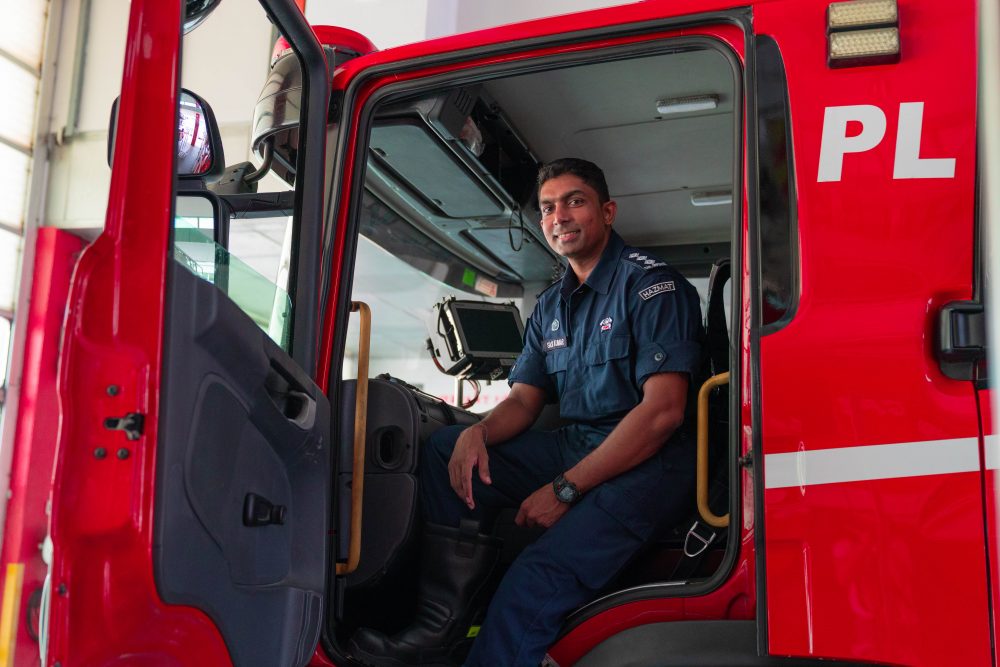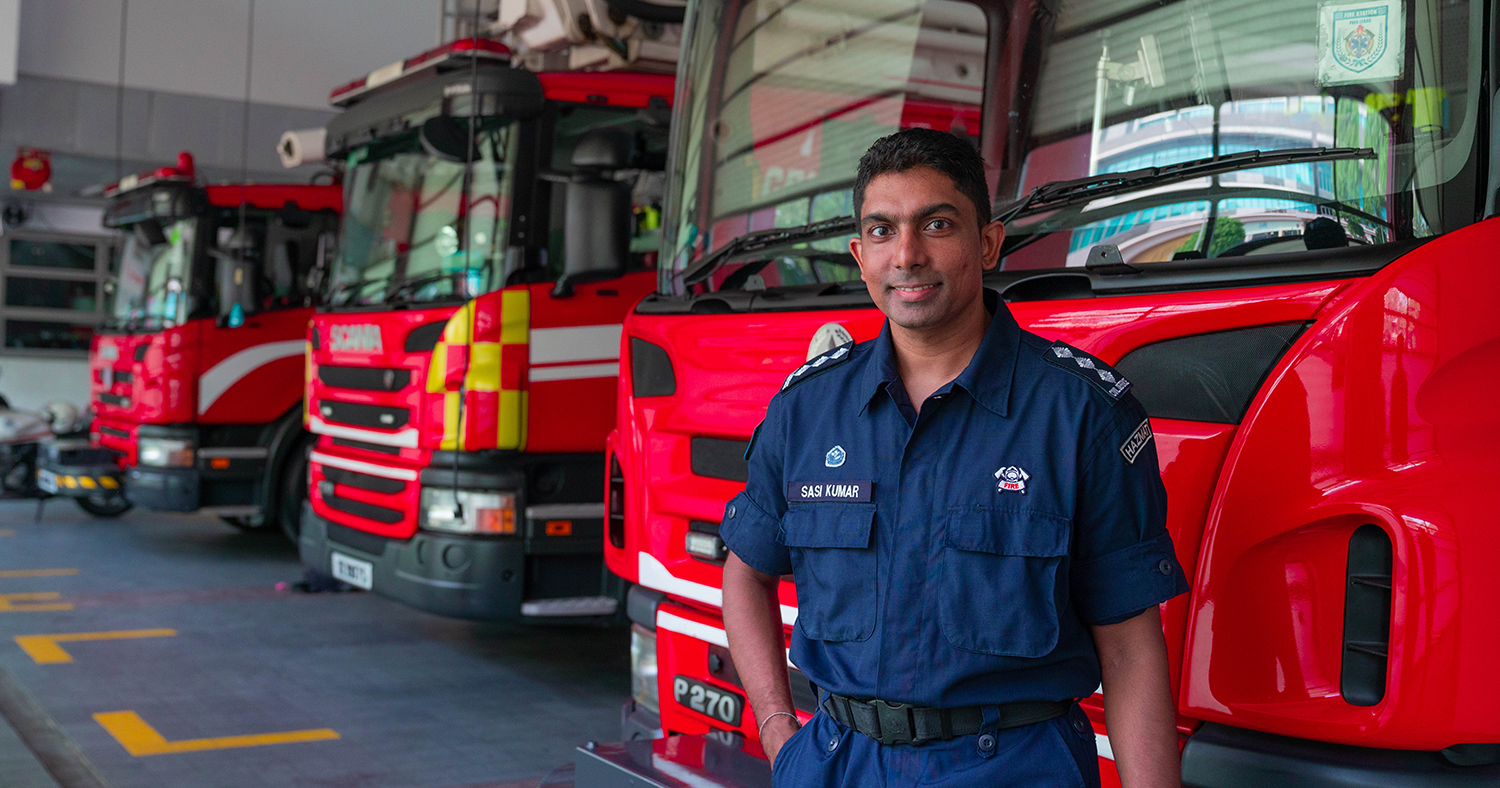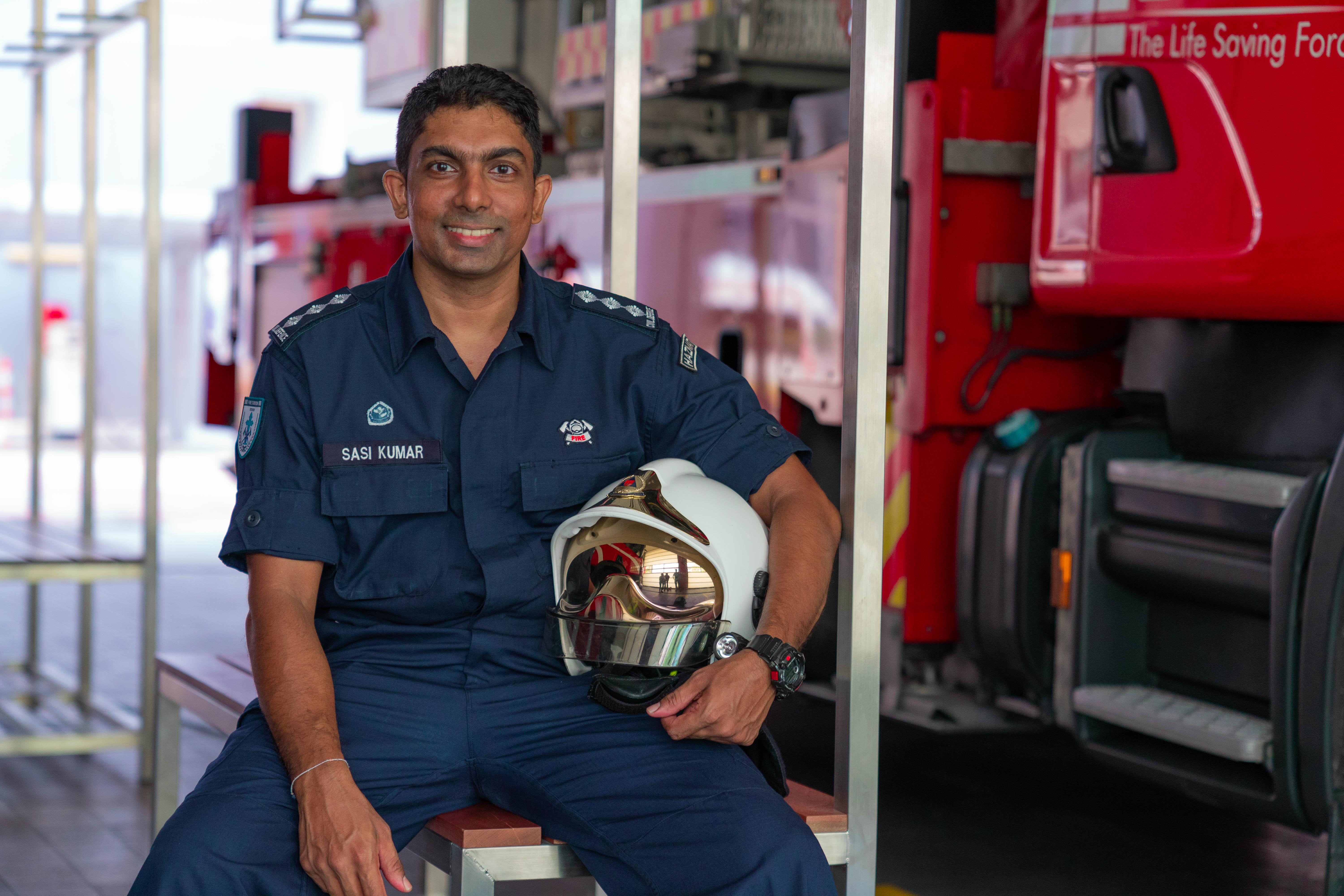At the not-that-old age of 37, Captain Sasi Kumar has had some pretty action-packed experiences as a firefighter.
In the course of his 13-year career with the Singapore Civil Defence Force (SCDF), the rota commander at Bishan Fire Station has seen his share of horrifying things — among the worst, he seems able to share with me in passing: brains spilled out across the road, and in one case you may also recall, a severed body on the MRT track.
The thought of these very tragic and painful deaths might send chills down most people's spines, but Sasi is, perhaps a bit sadly, quite immune to them now.
"The very first time you see a dead body, the fear will definitely be there and there will be a lot of questions in your mind. But after you see a few dead bodies the fear tends to go away. Now, seeing dead bodies and blood is part and parcel of my job."
Despite that, Sasi displays none of the battle-harden weariness you might expect of a veteran firefighter — if we can call him that, given his still-young age.
Instead, the fast-talking man exudes a friendly energy and is passionate to share about his work with the force, especially about the many lives he helped not just to save, but in many cases, revive.
One of Sasi's most memorable cases was a cardiac arrest victim in an Ang Mo Kio HDB flat, whom he attended to a few years ago:
"When I first arrived on scene, there was no pulse. The AED detected no pulse so I continued my CPR (Cardiopulmonary resuscitation), and later then I used my AED again, it said 'shock advised' so there was still hope, a pulse was detected. I was able to shock the victim (using the AED) just as the ambulance arrived. So I passed them all the information about the victim and she was conveyed to the hospital."
This was a case he responded to early on in a three-year period (2012 - 2014) he spent as a fire biker at Ang Mo Kio Fire Station.
Fire bikers: First responders on the ground
 CPT Sasi Kumar as a fire biker in 2012. Image courtesy of Sasi Kumar.
CPT Sasi Kumar as a fire biker in 2012. Image courtesy of Sasi Kumar.
You may or may not have noticed the SCDF's fire bikers before, but they've been around for decades now. The originally unheard-of concept first came up in 1992, when fast-response medics rode out on motorbikes to quickly get to a person in need of medical assistance before the ambulance arrived.
These guys' roles expanded five years later, when in 1997, the SCDF introduced a group of about 30 "super-firefighting-lifesaving heroes" (a term we've just coined ourselves) who can fight fire, conduct rescue operations, perform CPR and these days, surprisingly advanced medical treatment — all before the larger vehicles roll in.
Sasi speaks fondly of his time as a fire biker, sharing that their work is especially exhilarating because they're typically the first to respond to emergencies on the ground.
The SCDF sees, on average, a six per cent increase in ambulance calls annually since 2000. Responding to these calls as quickly as possible is paramount, and that is why fire bikers — seasoned fire and rescue specialists who are also medically trained — play very important roles.
Whenever you call 995, these fire bikers have less than a minute to gear up and be deployed as part of the pre-fire fighting phase, setting out with a compressed air foam backpack, a forcible entry tool bag, as well as an emergency medical technician kit.
In medical emergencies like cardiac arrests or strokes, having a fire biker arrive early can make all the difference because stabilising a victim before they are taken to the hospital is key to their survival.
Fire bikers are also equipped to do this thanks to their emergency medical technician kits, which have essential medical items like medical drugs, an oxygen cylinder and an automated external defibrillator (AED).
Keeping composed in the presence of onlookers, STOMPers & kaypoh pundits
As if the stress of an emergency isn't enough, fire bikers sometimes have to contend with environmental circumstances like language barriers or overly curious members of the public — like the time Sasi responded to another cardiac arrest case outside a church in Ang Mo Kio, whom he also, thankfully, revived:
"At that point, the only next-of-kin was the domestic worker. So I had problems communicating with her. The second challenge was the public. There were a lot of people looking at how I was performing!"
Sasi says that in situations like this, it's very important to first remain composed in order to think and carry out the required protocols.
Interestingly, though, he says bystanders can be quite helpful — especially those who come forward offering information about the victim's medical condition or residence.
"Even if you do one cycle of CPR or if you help us divert traffic just to allow us to park our vehicle, it's really really helpful for us."
 Sasi as a fire biker in 2012. Fire bikers are the first to respond to an incident. Image courtesy of Sasi Kumar.
Sasi as a fire biker in 2012. Fire bikers are the first to respond to an incident. Image courtesy of Sasi Kumar.
Sasi notes that even those who just stand around to film accidents are contributing in their own way.
Footage people send to the SGSecure or SCDF's MyResponder apps, he says, can contain vital information that the SCDF can use and transmit to their paramedics on the ground (so remember to upload your videos to those apps first before Facebook or sending it to your friends on WhatsApp).
How his NS experience derailed his plans to be an engineer
From the way Sasi's eyes light up whenever he talks about his work, you can tell he enjoys it tremendously.
Even though signing on with the SCDF wasn't part of his original plan, how he ended up doing so is a funny story from which he thankfully hasn't had regrets.
Sasi says that when he first graduated from Singapore Polytechnic's electrical engineering course, he thought he would work in the engineering field and possibly pursue further studies.
But his experience from his National Service stint in the SCDF as an NSF (full-time national serviceman) section commander at the Tuas fire station changed his mind.
"During this period when I was at Tuas fire station, I kind of enjoyed the life. Because the working hours were good. One day work, two days off!"
He would then sign on in 2006, attached to Ang Mo Kio fire station, and six years later was trained as a fire biker.
The prospect of working 10 days a month sounded as great to him as it does to us, but of course, what you actually do during those 10 days is a whole other story that should quite adequately explain why you need two days of rest after one day of work.
What happens in a fire station
At any one time, a fire station is manned by a rota (short for "rotational", an old name for a shift). A rota consists of three or four sections, depending on the size of the fire station.
During a shift, Sasi and his team perform routine checks on the appliances and then head out to do hydrant checks, operational surveys, and enforcement checks.
In the afternoon, the rota does their physical training, and in the evening, they have lectures.
When the fire station is activated, the fire bikers and in some cases the Red Rhinos are first deployed to the scene.
They are followed by the main fire station appliances such as the fire engines.
 Sasi enjoyed his national service with the SCDF so much that he decided to join them full time after his ORD. Image by Ng Kah Hwee.
Sasi enjoyed his national service with the SCDF so much that he decided to join them full time after his ORD. Image by Ng Kah Hwee.
Upon arrival, the fire bikers will provide crucial information, conduct forcible entry if necessary, and initial firefighting by using their compressed air foam backpack before the arrival of the rest of the crew.
Simultaneously, the fire fighters will don their 15kg fire fighting suits and prepare to move in.
The main phase involves entering the burning unit and start fire-fighting, ensuring adequate ventilation, and rescuing trapped victims if needed. The goal here is to get the fire under control so that there is minimal risk of it getting bigger.
Once the fire is under control, the crew searches the location for small pockets of fire or embers to make sure everything is put out, and the smoke is dispersed.
"Sometimes a small ember might re-ignite and then create another fire again. So you want to prevent this from happening," Sasi explains.
Then comes what is called the damping down process where water is used to cool down the affected surfaces so that they do not reignite from the heat. In some cases, like higher-profile Jurong factory fires, this can take many hours and involve many firefighters.
Feeling tired yet? The work doesn't end with the last vehicle leaving the scene. The team also has to carry out an investigation into each fire, conducting interviews, examining the scene, collecting samples, and searching for fire patterns.
Dangerous but exciting
It is physically challenging and dangerous and at times, it worries Sasi's family members, especially his wife, who texts him often to check in on him.
"The tendency to be worried is there. Every family member will be worried. No matter how many hundreds of safety protocols you have, sometimes, you never know, something might just happen. But we just don't want to make our family members worry."
The father of one is quick to add that the SCDF has safety protocols in place and he shares them with his family to keep them at ease.
Despite the danger, Sasi relishes the challenge and the excitement of his job.
"They always say that no two fire incidents are the same. Today you can respond to a minor rubbish bin fire, but tomorrow you might respond to a bigger incident, like a factory or warehouse (fire)."
Encountering a factory fire for the first time
Sasi will never forget the first fire he encountered as an NSF — a factory fire in Tuas.
"It was quite scary because I was seeing a full factory blazing. I was quite blank because I was seeing it for the first time and I didn't expect a fire at this scale," he says, grinning.
In the literal heat of the moment, all Sasi could manage was to follow his seniors' instructions and set up the water jets and follow his more experienced fellow crew.
The team took three hours to put out the fire from 10pm to 1am, but with the damping down, Sasi and his colleagues only managed to return to Tuas fire station at 7am the next day.
Rescuing a lady and her month-old infant from a shophouse engulfed in fire
His time at Ang Mo Kio fire station was certainly different from his experiences during his NS days mainly because the fire cases they respond to tend to be residential (like kitchen or rubbish bin fires) while those in Tuas tend to be more industrial in nature, like chemical fires.
Sasi remembers an exciting fire/rescue mission that he responded to just six months after joining the Ang Mo Kio fire station.
The fire broke out in a shophouse clinic in Ang Mo Kio Avenue 10, trapping a mother and her baby in the second-floor unit above.
While the clinic was fully engulfed in the fire, the mother was carrying her one-month old baby and standing at the kitchen window," recounts Sasi.
Sasi himself was tasked with firefighting so he set up the water jets while another section pitched the ladder to rescue both mother and child.
At the same time, another section assisted Sasi's firefighting section while another helped to evacuate other people in the neighbouring units.
And of course, the most in-vogue type now: PMD fires
Sasi has also seen his share of PMD fires, recalling one in particular that caught fire while charging outside an HDB flat.
"When the fire broke out, it affected everything that was placed along the corridor, like the shoe rack, the electrical wirings, the neighbours' shoe rack. Thankfully, we arrived as quickly as possible and members of the public assisted us by pouring buckets of water," he says.
PMD fires, he notes, can actually be quite intensive. Sasi himself has in recent times dealt with many PMD fires that spread so quickly that entire rooms were engulfed by the time the SCDF arrived.
Time for a PSA: If a PMD fire ever occurs in your house, the SCDF advises that you close your doors before you evacuate your house — doing so helps to slow its spread.
From fire biker to rota commander
 Over his 13 years with the SCDF, Sasi has won two Minister for Home Affairs National Day Awards. (Photo by Ng Kah Hwee)
Over his 13 years with the SCDF, Sasi has won two Minister for Home Affairs National Day Awards. (Photo by Ng Kah Hwee)
In 2016, Sasi took on the role he has now: a rota commander at Bishan fire station, where he heads some 25 section commanders and firefighters.
"Now I'm seeing things from a macro point of view where I delegate the tasks to the guys and take charge of their safety," he says.
He also clinched his second Minister for Home Affairs National Day Award in August this year — the first being four years ago — given to Home Team individuals who perform outstanding work.
"I definitely feel happy and a sense of satisfaction. And of course I also feel my supervisors and organisation recognised my good work and awarded me for it."
Aside from his fire-fighting duties, Sasi also established a Fire Safety Specialist Course for secondary school students in the National Civil Defence Cadet Corps in 2016.
He also a liaison officer for foreign delegates and an ambassador who promotes the SCDF as a career option for graduates (and it is at this point he tells me that one of the most common questions he gets at schools is whether the SCDF has female firefighters. Yes, he says, of course they do).
Looking back, Sasi says, rather earnestly, that he has never thought of doing anything else aside from this. 13 years and about 200 incidents later, this "veteran" rightfully shows no sign of slowing down.
Top photo by Ng Kah Hwee.
If you like what you read, follow us on Facebook, Instagram, Twitter and Telegram to get the latest updates.
